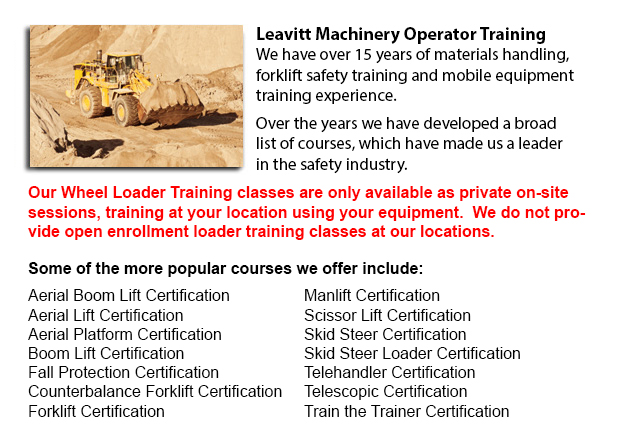
Guelph Wheel Loader Operator Training - To be able to lift substantial loads, industrial cranes utilize levers and pulleys. Before, Romans used cranes to be able to build huge monuments making the origin of these machinery at least 2,000 years ago. Numerous Medieval churches utilized cranes in their construction as well as the Egyptians may have relied on them when constructing the pyramids.
New cranes can either be complex or simple, based upon the nature of the function they could carry out. For example, mobile cranes are quite simple models. A telescopic boom and even a steel truss mounts its movable platform. A system of pulleys or levers raises the boom and there is normally a hook hanging. These cranes are often intended for demolition or earthmoving by changing the hook out with one more piece of device like a wrecking ball or a bucket. Telescopic cranes have a series of hydraulic tubes which fit together to form the boom. These units could also be mobile.
Traditional wheels, or certain wheels designed for a railroad track or caterpillar track allow these mobile booms to navigate unpaved and uneven surfaces.
Truck mounted and rough terrain cranes are even mobile with outriggers situated on the truck mounted unit improve stability. Nevertheless, rough terrain cranes comprise a base which tends to resemble the bottom of a 4-wheel drive. These cranes are equipped so as to work on uneven surface making them ideal in the construction industry for instance.
Normally used on railroads and in ports, the Gantry crane could transfer and unload huge containers off trains and ships. Their bases consist of very big crossbeams which run on rails in order to raise containers from a place to another. A portainer is a special type of gantry that transports materials onto and off of ships in particular.
Important to the shipping industry, floating cranes can be connected on barges or pontoons. Being placed in water, they are perfect for use in salvaging ships, building bridges and port construction. Floating cranes can handle very heavy cargo and containers and similar to portainers, they can also unload ships.
Loader cranes have hydraulic powered booms that are fitted onto trailers in order to load merchandise onto a trailer. The jointed sections of the boom could be folded down when the machinery is not in use. This particular type of crane can be also considered telescopic as a part of the boom can telescope for more versatility.
Stacker cranes are normally utilized in automated warehouses. They tend to follow an automated retrieval system and can operate through remote. These cranes are equipped with a forklift apparatus and can be seen in huge automated freezers, obtaining or stacking food. Utilizing this type of system enables personnel to remain out of that cold setting.
Tower cranes, often the tallest kind, typically do not have a movable base. They have to be assembled part by part. Their base is similar to a long ladder along with the boom at a 90 degree angle to the base. These cranes specialize in the construction of tall structures and are normally affixed to the inside of the building itself during the construction period.
-
Guelph Warehouse Forklift Training Classes
Guelph Warehouse Forklift Training Classes - Warehouse training classes exist for the reason of raising awareness regarding common warehouse hazards. Students learn the important safety procedures that are necessary to warehouse safety. An emphasis i... More -
Guelph Forklift Operator Certification
Guelph Forklift Operator Certification - Certification for forklifts are needed to guarantee the safe use of forklifts for those employers in construction, industrial and warehouse settings. The training has to involve a method of education plus some... More -
Guelph Crane Training School
Guelph Crane Training School - The crane training school offers industry-relevant programs. Courses provide trainees with learning results that match current industry demands. Our small class sizes combine hands-on experience and theory. Our qualifie... More -
Guelph Heavy Equipment Training Programs
Guelph Heavy Equipment Training Programs - At whatever given construction site, there are usually various kinds of machines that are ready to be used. These heavy and light equipment need both operators to run them and mechanics to fix them. Apprenti... More -
Guelph Skid Steer Ticket
Guelph Skid Steer Ticket - On a skid-steer loader, the lift arms are at the side of the driver together with pivot points at the back of the driver's shoulders. This makes them different compared to a traditional front loader. Because of the operator... More -
Guelph Zoom Boom Ticket
Guelph Zoom Boom Ticket - Zoom Boom Training focuses on correctly training prospective operators on variable reach forklifts. The training goals include gaining the understanding of the equipments physics and to define the tasks of the operator. This... More -
Guelph Heavy Equipment Training
Guelph Heavy Equipment Training - Commonly, the different types of heavy equipment training are divided into 2 categories of machinery: those that have rubber tires and tracked vehicles. Tracked vehicles consist of items like for instance bulldozers,... More -
Guelph Aerial Lift Safety Training
Guelph Aerial Lift Safety Training - Each year, there are roughly 26 construction deaths due to the use of aerial lifts. Nearly all of the craftsmen killed are laborers, electrical workers, carpenters, painters or ironworkers. Nearly all deaths are c... More

Forklift Certification Guelph
TOLL FREE: 1-888-254-6157
Guelph, Ontario
forkliftcertificationguelph.com
Email Us
About Us


